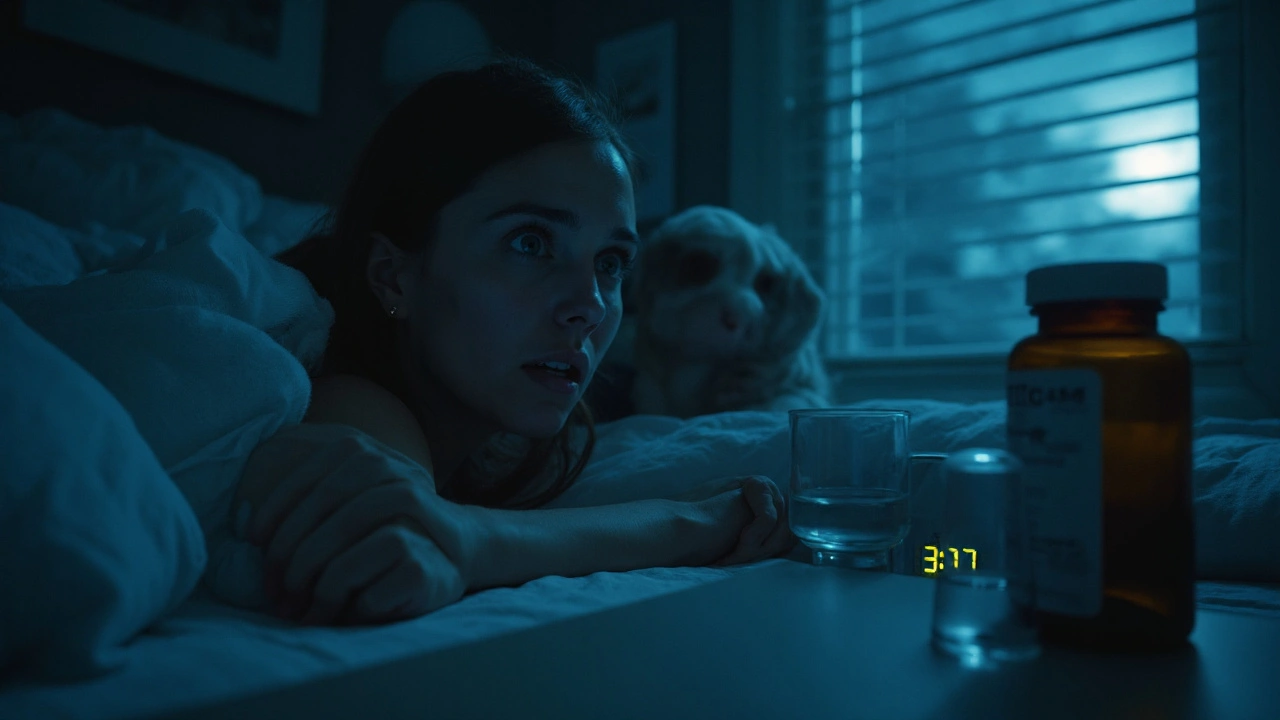
TL;DR
- Yes, meloxicam sleep problems happen for some people-usually insomnia, restless nights, vivid dreams, or drowsiness. They’re uncommon but real.
- Two big culprits: reflux/indigestion waking you up and a timing mismatch (dose peaking right when you’re trying to sleep).
- Quick fixes: take meloxicam with food, shift it to the morning if it wires you, or to the evening if it makes you sleepy; avoid alcohol and late caffeine; protect your stomach if you’re high risk.
- Track a 7‑day sleep-medicine diary. If sleep still suffers, talk to your GP/pharmacist about dose tweaks, switching NSAIDs, or adding gastroprotection.
- Red flags (seek urgent care): chest pain, breathlessness, swelling of face/tongue, black stools, vomiting blood, severe stomach pain.
What meloxicam can do to your sleep (and why your nights feel off)
Meloxicam is a once‑daily non‑steroidal anti‑inflammatory drug (NSAID) used for osteoarthritis and rheumatoid arthritis pain. It’s usually prescribed at 7.5 mg to 15 mg per day. In the UK you’ll see it in the British National Formulary and on the NHS Medicines A‑Z; in the US, the FDA label lists known adverse effects. Across those sources, the sleep story is nuanced: meloxicam can help sleep by easing pain, yet a minority report insomnia, odd dreams, or daytime sleepiness.
Here’s the physiology in plain English. NSAIDs reduce prostaglandins. That’s how they cut pain and inflammation. Prostaglandin D2 also nudges the brain toward sleep. Research in humans has shown that non‑selective NSAIDs such as ibuprofen and aspirin can suppress nocturnal melatonin output (for example, a Clinical Pharmacology & Therapeutics paper from the mid‑1990s). Meloxicam preferentially targets COX‑2, but it still inhibits COX pathways, so some spillover into sleep regulation is plausible even if direct melatonin data for meloxicam are limited.
There are two practical pathways you’ll actually notice in bed:
- Digestive discomfort: dyspepsia, reflux, and nausea are common NSAID effects. Lying down magnifies reflux, which jolts you awake or keeps you half-asleep and burpy. NHS and BNF both emphasise taking meloxicam with food and assessing GI risk.
- Timing and peaks: meloxicam’s half‑life is around 20 hours, but the concentration still rises after a dose. If you take it at dinner, your peak might land in your first sleep cycle. Some people feel wired, some feel heavy-eyed.
What symptoms are actually reported? Across product information and pharmacovigilance data: headache, dizziness, drowsiness, and insomnia appear. These are uncommon but documented. Vivid dreams crop up anecdotally. Fluid retention can worsen snoring or nasal stuffiness for a few people, though that’s not a classic finding.
None of this makes meloxicam a “bad” medicine. Most people sleep fine-often better-because their pain is under control. The trick is spotting when the tablet is the reason your nights turned jittery.
Spotting meloxicam‑related sleep problems (and ruling out look‑alikes)
If your sleep went sideways soon after starting meloxicam or increasing the dose, the drug is a suspect. Still, sleep has lots of moving parts-pain flare patterns, caffeine habits, alcohol, screens, other meds, and existing sleep disorders like sleep apnoea. A quick process helps you separate signal from noise.
Use this 7‑day sleep-medicine diary (keep it simple):
- When you took meloxicam (time and dose) and whether you took it with food
- Other meds that day (especially other painkillers, steroids, decongestants, antidepressants, antihistamines, alcohol)
- Caffeine: total cups and last cup time
- Bedtime/wake time, time to fall asleep (estimate), night wakings and triggers (reflux, pain, bathroom)
- Morning: groggy, rested, or wired?
Patterns to look for:
- Insomnia 2-6 hours after the dose suggests timing is the problem.
- Burning in the chest or sour taste when lying down points to reflux. That’s the NSAID irritating your stomach/oesophagus more than a “brain” sleep effect.
- Daytime nodding off or fogginess soon after your morning dose? Evening dosing may suit you better.
- Awakening with joint pain a few hours before your usual wake time may mean your pain control is wearing off, not that the drug is causing insomnia.
Rule‑out checklist (things that masquerade as medicine‑caused insomnia):
- Late caffeine (after 2 pm), energy drinks, or decongestant sprays
- Evening alcohol (worsens reflux and fragments sleep)
- Other meds started recently that are notorious for sleep disruption: SSRIs (early weeks), SNRIs, oral steroids, bupropion, pseudoephedrine
- Big evening meals, spicy foods, chocolate, peppermint-classic reflux triggers
- Lack of morning daylight and late screen time
- Untreated sleep apnoea: loud snoring, witnessed apnoeas, morning headaches
When the diary screams “meloxicam”: the sleep change started within a week of initiation or dose increase, lines up with your dosing time, and gets better on days you skip or shift the dose (do not skip without speaking to your prescriber if you’ve been told to take it daily; for short observational trials, ask your pharmacist or GP first).
Who is more likely to feel it? People with a history of reflux, older adults, those on SSRIs/SNRIs (higher GI risk), heavy evening caffeine, and anyone taking other NSAIDs by mistake (ibuprofen on top of meloxicam is a common error). The BNF and NHS both warn against combining NSAIDs and advise using the lowest effective dose for the shortest time.

Fixes that actually help tonight (timing, food, routines, and safer combos)
Start with the low‑effort wins. Most people don’t need a new prescription-just better timing and reflux prevention. Pick one or two changes, try them for 3-5 nights, and check your diary.
- Match your dose to your symptom. If meloxicam keeps you awake, move it to the morning with breakfast. If it makes you sleepy, shift it to the early evening with food. Because of the long half‑life, choose a time and stick to it daily to avoid yo‑yo effects.
- Always take with food. A proper meal or a snack with protein/fat (e.g., yoghurt and toast) is enough. Avoid lying down for at least 30-60 minutes after dosing.
- Guard your oesophagus. Elevate the head of your bed a bit, avoid big meals two hours before bed, skip trigger foods at dinner (spicy, acidic, chocolate, peppermint, onions). If you’ve had ulcers, are over 65, or take SSRIs/anticoagulants, ask your GP if you need a proton pump inhibitor for gastroprotection.
- Close the caffeine window. No caffeine after 2 pm if you’re sensitive. It sounds basic, but it rescues a lot of people.
- Hold the nightcap. Alcohol plus NSAIDs raises GI bleed risk and worsens reflux and snoring. If sleep is rough, go dry for a fortnight and see.
- Use pain‑neutral sleep supports. Heat pack before bed for stiff joints. Gentle stretches. Morning daylight and a consistent wind‑down routine (15 minutes of something boring and calm) help the brain downshift.
- Keep other painkillers clean. Paracetamol can be paired with meloxicam if you need extra relief. Avoid stacking other NSAIDs (ibuprofen, naproxen, diclofenac) unless a clinician explicitly tells you to.
Quick reference table for night symptoms:
| Night symptom | Likely driver | Try this first |
|---|---|---|
| Can’t fall asleep, mind wired | Dose peaking near bedtime | Move dose to breakfast for 1 week; no caffeine after 2 pm |
| Wake with burning chest/sour taste | Reflux from NSAID irritation | Take with food earlier; elevate head; avoid late meals; ask about PPI if high risk |
| Groggy next morning | Sedative side effect or poor sleep quality | Shift dose to early evening; check alcohol; simplify bedtime routine |
| Early‑morning pain wakes you | Pain control wearing thin | Keep dose time steady; add paracetamol at bedtime if advised; discuss dosing time with GP |
Decision guide for timing:
- If sleep latency (time to fall asleep) increased by 30+ minutes and starts within 3 hours of dosing, move meloxicam to the morning.
- If you feel heavy‑eyed within 2-3 hours of dosing, move it to early evening with dinner.
- Give any timing change 3-5 days to judge.
What about sleep aids?
- Melatonin: no strong evidence of a harmful interaction with meloxicam. If you’re on anticoagulants or antiplatelets, check with a pharmacist because melatonin can theoretically affect bleeding risk in some contexts.
- Antihistamine sleep aids (diphenhydramine, promethazine): can help short term but often leave people hungover the next day. Higher risk of confusion, falls, and urinary retention in older adults. Use sparingly and avoid in the elderly unless a clinician says it’s okay.
- Herbal teas (chamomile), magnesium: generally safe, but keep expectations modest. Avoid valerian if you’re on multiple sedatives.
Practical sleep‑safe checklist for meloxicam nights:
- One NSAID only (meloxicam). If in doubt, ask your pharmacist to check your meds.
- Take with food; no lying flat for an hour after.
- Morning dosing if it stimulates you; evening dosing if it sedates you.
- No caffeine after 14:00; no alcohol at night while you’re troubleshooting.
- Stomach protection plan if you’re high risk (age 65+, prior ulcer, anticoagulants, SSRIs/SNRIs): discuss a PPI.
- 7‑day diary to track cause and effect.
When to change the plan: dose tweaks, swaps, and red‑flag safety
If you’ve tidied up the basics and your sleep is still a mess, it’s time to involve a clinician. Bring your 7‑day diary; it speeds decisions and avoids guesswork.
Options your GP or pharmacist may consider (this is UK‑leaning but broadly applies):
- Reduce the dose. Many start at 7.5 mg and only go to 15 mg if needed. If sleep problems appeared after an increase, stepping back often fixes it.
- Switch the NSAID. Some people sleep better on a different agent. Topical NSAIDs (diclofenac or ibuprofen gel) can relieve local pain with less systemic effect and may improve nights for knee/hand OA.
- Consider a COX‑2 selective option. Celecoxib may be easier on the stomach for some, though cardiovascular risk must be weighed. Your GP will check your history.
- Add gastroprotection. If reflux is the barrier to sleep and you’re a candidate, a PPI can quieten the fire so you can rest.
- Add non‑NSAID pain cover at night. Paracetamol is often fine alongside meloxicam. For neuropathic pain, other classes (e.g., low‑dose amitriptyline or gabapentin) may be considered, but they come with their own sleep effects and need medical supervision.
When to stop and seek help fast (don’t wait this out):
- Allergic reaction: wheeze, swelling of lips/tongue/face, hives, sudden breathlessness
- GI bleeding: black tarry stools, vomiting blood or coffee‑ground material, severe stomach pain
- Chest pain, sudden shortness of breath, new leg swelling
- Severe, persistent headache, confusion, fainting
Who to speak to and what to bring:
- Pharmacist first: they can audit your meds for hidden NSAIDs, spot interactions, and suggest timing and protection strategies.
- GP appointment: bring your diary. Ask about dose reduction, alternative NSAIDs or topical options, and whether you need gastroprotection.
- If you have known kidney, heart, or ulcer disease-or you’re pregnant-don’t self‑tinker. Get advice before moving anything around.
Mini‑FAQ (quick, no‑nonsense answers)
- Does meloxicam cause insomnia? Uncommon, but reported in prescribing information and pharmacovigilance. Often it’s reflux or timing rather than a direct “brain” stimulant effect.
- Can I take meloxicam at night? Yes, if it makes you drowsy or you need night pain cover. If it keeps you awake, switch to morning.
- Is meloxicam with paracetamol safe at bedtime? Generally yes, and often useful. Avoid layering another NSAID on top.
- Can I use melatonin with meloxicam? Usually fine, but if you take blood thinners or multiple sedatives, check with a pharmacist.
- How long do sleep side effects last? Many settle within a week as your body adjusts. If not, change timing or speak to your clinician.
- Should I stop meloxicam suddenly? There’s no withdrawal, but your pain may bounce back. If you’re on it for a reason, call your prescriber first.
- Pregnancy or trying to conceive? NSAIDs have timing‑specific risks in pregnancy. Get personalised advice; don’t self‑medicate.
Credible sources behind this advice: NHS Medicines A‑Z (meloxicam), British National Formulary monograph for meloxicam, FDA Prescribing Information for meloxicam (MOBIC), European Medicines Agency product information, and peer‑reviewed studies exploring NSAIDs’ effects on melatonin and sleep regulation. These sources align on core risks (GI, renal, cardiovascular), the need for lowest effective dose, and the importance of taking NSAIDs with food-key points that map directly to better nights.
Last bit of practical coaching: if your diary shows that a simple timing shift plus food handled the problem, keep that routine for a full month before you try to “optimize” further. Stability helps your sleep system recalibrate. If it didn’t help, bring the diary to someone who can adjust the plan safely. Good sleep is part of good pain care-you shouldn’t have to pick one.
10 Comments
Alice L
August 30 2025
I commend the meticulous detail presented herein.
Seth Angel Chi
August 31 2025
While the recommendations are useful they lack a deeper pharmacodynamic perspective.
Kristen Ariies
September 1 2025
Wow!!! This guide is a game‑changer for anyone wrestling with restless nights-your step‑by‑step plan feels like a beacon of hope!!! I’m thrilled to try the morning dosing shift and the reflux‑proof tips-thank you for the energy and clarity!!!
Ira Bliss
September 2 2025
Great stuff! 🌟 I love the emoji‑friendly vibe-definitely going to add a nightly magnesium supplement and keep the caffeine window closed after 2 pm. 👍💤
Donny Bryant
September 3 2025
Good info. I will try taking it with breakfast and see if my sleep gets better. Simple changes can make a big difference.
kuldeep jangra
September 4 2025
When I first read about meloxicam’s impact on sleep, I was skeptical, but after experimenting with timing and diet, I can attest to the importance of these adjustments. Taking the medication with a solid breakfast rather than at night reduced my nighttime awakenings dramatically. Moreover, I discovered that even a light snack containing protein can buffer the gastrointestinal irritation that often leads to reflux. Elevating the head of the bed by a few inches proved to be a surprisingly effective strategy, as it prevented the acid from traveling upward during sleep. Adding a daily probiotic helped stabilize my gut flora, which some studies suggest may influence overall inflammation and, indirectly, sleep quality. I also found that consistent bedtime routines, such as a short meditation session, reinforce the body’s circadian rhythm, making the meloxicam peak less disruptive. If you are at higher risk for ulcers, discussing a proton‑pump inhibitor with your doctor is a wise precaution. Remember that abrupt discontinuation can cause a flare‑up of joint pain, which itself is a major sleep disruptor. Lastly, keep that seven‑day diary; it’s an invaluable tool for communicating with healthcare providers and fine‑tuning your regimen.
harry wheeler
September 5 2025
Timing matters-move the dose to breakfast and watch the night improve.
faith long
September 6 2025
Enough with the vague suggestions! If you keep ignoring the clear link between NSAID‑induced reflux and insomnia, you’ll stay miserable night after night. The guide mentions diet adjustments, but you must enforce a strict no‑lying‑down‑after‑eating rule for at least an hour. Stop blaming the medication alone and recognize that poor sleep hygiene compounds the problem. Take control: schedule the dose, protect your stomach, and eliminate late‑night stimulants now.
Danny Wakefield
September 7 2025
Ever wonder why pharma pushes NSAIDs without warning about sleep disturbances? It’s all part of the larger scheme to keep us dependent on prescription meds while the side‑effects slip under the radar. By tweaking the timing and adding extra supplements, you can outsmart the system, but always stay vigilant-there’s more they don’t want you to know.






keyul prajapati
August 30 2025
When I first noticed my nights becoming restless after starting meloxicam, I began to track every factor that could be influencing my sleep, from the timing of the dose to the composition of my dinner. I discovered that taking the medication with a substantial meal reduces the likelihood of reflux, which is a common trigger for nocturnal awakenings. The drug’s half‑life of around twenty hours means that its plasma concentration peaks several hours after ingestion, so aligning the dose with breakfast can prevent the peak from coinciding with the early sleep cycles. In my case, moving the dose to the morning eliminated the feeling of being wired at bedtime and allowed my melatonin rhythm to re‑establish itself. I also found that avoiding caffeine after 2 p.m. helped, because caffeine can synergize with the subtle stimulant effect some users report. Elevating the head of the bed by a few centimeters further mitigated the acid‑reflux episodes that would otherwise wake me. Adding a proton‑pump inhibitor after consulting my GP provided an extra layer of protection for my stomach lining, especially given my prior history of ulcers. It is essential to keep a simple seven‑day diary, noting the exact time of the dose, food intake, and any night‑time symptoms, as this data can be presented to a pharmacist or physician for a more informed discussion. If daytime drowsiness persists, shifting the dose to early evening with dinner can be beneficial, but one must monitor for early morning grogginess. Should the insomnia continue despite these adjustments, a dose reduction or a switch to a topical NSAID may be advisable. Always remember that sudden cessation of meloxicam without medical guidance can lead to a rebound of pain, which itself disrupts sleep. Moreover, combining meloxicam with other NSAIDs, such as ibuprofen, should be avoided due to increased gastrointestinal risk. For patients over 65 or those on anticoagulants, a gastroprotective regimen is often warranted. Finally, if any red‑flag symptoms appear-such as black stools, severe abdominal pain, or respiratory distress-seek urgent medical attention.